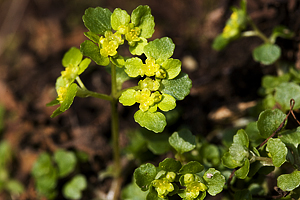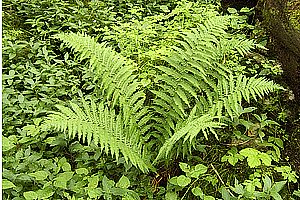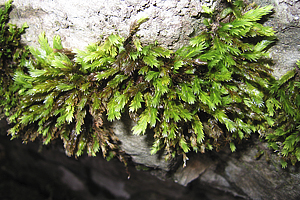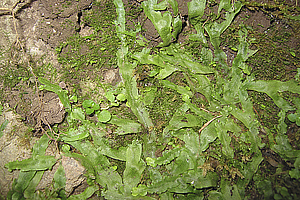 |
Cave Life of Wales |
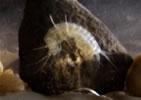 |
| |
| HOME |
| INTRODUCTION |
| LIFE IN THE ENTRANCE |
| LIFE IN THE CAVE |
| CONSERVATION |
| GLOSSARY |
| ACKNOWLEDGEMENTS |
Life in the entrance |
||||||||
As you move from outside the cave entrance into the cave threshold there is a change in the nature of plant life. This corresponds to changes in the habitats. There is a decrease in the amount of light and the increased shelter reduces wind and helps to maintain humidity (combined with the damp air in the cave). The proximity of an entrance means it will remain cool but relatively frost free. FLOWERING PLANTS Shade loving plants (sciophytes) will grow around the entrances of caves. There are three species of flowering plant commonly found in cave entrances that can cope with light levels down to 24 lux – Herb Robert (Geranium robertianum), Wood Sorrel (Oxalis acetosella) and Opposite Leaved Saxifrage (Chrysosplenium oppositifolium). (There are different methods of measuring light. Lux is one - a living room may be 60 lux, an office 400 lux and in sunlight may produce 50,000 lux).
Other typical flowering plants of the threshold include Ivy (Hedera helix), Cuckoo Pint or Lords and Ladies (Arum maculatum), Stinging nettle (Urtica dioica), Dog Violet (Viola riviniana) and Dog’s Mercury (Mercurialis perennis) which prefers drier conditions. In deep shade some plants have a different form with larger leaves e.g. Dog Violet, the mosses Eucladdium vertillatum, Adoxa and Phyllitis spp.and the Asplenium ferns. Plants have a chemical (bit like chlorophyll) that switches its formula depending on light intensity. If light is low it exists in a form that prompts the plant to grow taller in an effort to reach more light (this is why seedlings in caves are often tall and spindly with a token leaf at the top). Limestone soils are generally dry, well aerated and warm; waterlogging is not a problem. The soil and organic matter around entrances can produce locally acid conditions, this allows the growth of plants not normally associated with basic limestone soils e.g. Wood Sorrel. Fossils of ferns date back to 400 million years ago, about 300 million years before the first flowering plants appeared. Some ferns can grow in deep shade with light intensities down to 18 to 10 lux; one species, Rusty Back Fern (Ceterach officinarum), can cope down to 5 lux. Both mosses and ferns are restricted to damp shady areas due to the need for water for the male gametes and to complete their reproductive cycle (Flowering plants have evolved to overcome this problem). The Shield ferns (Polystichum sp.) are common round cave entrances of Wales – the Soft Shield fern (P. setiferum) and the Hard Shield Fern (P.aculatum) grow on the slopes by the main entrance of Porth yr Ogof.
Nearer the entrances and growing on the walls you may see Harts Tongue Fern (Phyllitis scolopendrium), Brittle Bladder Fern (Cystopteris fragilis), and Maidenhair Spleenwort (Asplenium tichomanes). The latter is also found sometimes found near show cave lights. The Brittle Bladder Fern (Cystopteris fragilis) prefers damp heavily shaded conditions, the fronds can be found hanging from vertical faces often alongside Maidenhair Spleenwort. Wall Rue (Asplenium ruta-muraria) prefers brighter conditions like those found on a cliff top. The Male Fern (Dryopteris filix-mas) prefers neutral conditions and can be found around cave entrances. The Male Fern dies back each winter. The British Polypody species are similar and also hybridise making identification difficult. Southern Polypody (Polypodium australe) grows in limestone areas of south and west Britain, the Common Polypody prefers acidic conditions throughout Britain, and the Western Polypody (Polypodium interjectum) prefers weakly acid or basic rocks and soils in western Britain. The Limestone Polypody (Dryopteris robertiana) is a rare fern. Polypody species are often found growing as epiphytes on tree trunks. Some species prefer more acidic conditions than can occur around cave entrances. The Mountain or Lemon-scented Fern (Oreopteris limbosperma) prefers acid conditions but can be found on limestone in moist, peaty woodland soils or where the lime has been leached from the soil e.g. in the hazel woods by Bridge Cave. Hard Fern (Blechnum spicant) may be found on steep, damp, humus rich pockets, for example where water running down from more acidic conditions higher up causes leaching and results in conditions too acidic for the Shield Ferns or the Harts Tongue Fern. Lady Fern (Athyrium-femina) is a good indicator of more acidic conditions and is found just south of Pwll y Rhyd. Other ferns include the rarer Limestone Fern (Gymnocarpium robertianum) looking like a mini Bracken, Green Spleenwort (Asplenium viride), Rigid Buckler Fern (Dryopteris submontana) and Bracken. MOSSES Mosses and liverworts are Bryophytes - simple green plants that have the ability to suspend their metabolism when desiccated (unlike a flowering plant that shrivels up and dies). Because they have no roots most of them absorb water, nutrients and gases over their whole surface. Like lichens they can be used as indicators of air and water pollution. Closer to the entrance the shade increases and the ferns are replaced by mosses and liverworts - mosses are commonest at 10 lux, liverworts at 10 to 5 lux. As the light decreases only green algae and blue green algae (cyanobacter) are found. Thamnobryum alopecurum, Fox-tail Feather-moss, is abundant on rocks at and just above water level. This is the dominant moss on the water splashed rock just behind the entrance cascade of Ogof Clogwyn. It is a tall moss with a characteristic stiff stem. Eurhynchium striatum, Common Striated Feather-moss, is very common is south Wales growing abundantly on boulders and walls around entrances. It is tolerant of low light and can survive by show cave lights. This tall yellow green moss forms extensive soft cushions on shaded rocks and soil. Plagiomnium undulatum is common on walls by damp entrances e.g. Tradesmans Entrance to Porth yr Ogof. There are several Fissidens species found in the entrance to caves, some of which are very tolerant to low light and will be found in the threshold.
Typical mosses in the more shaded parts of a limestone pavement (i.e. in the grikes) are the yellow-green Ctenidium molluscum with its curved leaves, Fissidens adianthoides and Neckera crispa. Different species of moss can be found growing by lights in the Dan yr Ogof showcave, they will be in total darkness when the show cave is closed (around 16 hours a day). Some mosses form dense cushions e.g. Eucladium verticillatum; this one along with Cratoneuron filicinium (a golden green pinnate) prefers wetter habitats e.g. springs, where it forms the basis of the tufa dams. Eucladium and Palustriella commutata are tufa forming species, the mosses actively promoting the deposition of carbonate from seepage water. Tufa eventually hardens into a porous brown limestone called travertine. On Gower Heterocladium hetopterum is found in the sea caves. Orthotrichum anomalum grows on base-rich rocks (such as Carboniferous limestone) and artificial walls, buttresses etc., usually in exposed situations. It forms neat dark-green cushions. LIVERWORTS Liverworts are not quite as desiccation tolerant as mosses and so prefer moister habitats. The liverwort Conocephalum conicum is very common in cave entrances and becomes more stunted the further into the cave it grows. It is also one of the most common liverworts of sea caves.
Another common liverwort of cave entrances is Pellia endiviifolia, Endive Pellia, this can be seen near the entrance cascade of Ogof Clogwyn. Other liverworts found in the grikes of limestone pavements include Scapania aspera and Preissia quadrata. ALGAE Algae are mostly unicellular simple plants which use photosynthesis to obtain energy, producing oxygen as a by-product. Green algae use chlorophyll a and b, whilst the yellow brown algae and diatoms use chlorophyll a and c. Brown and red algae are found in the sea. A few species can cope with no light for varying lengths of time and can become a problem in show caves, especially if the lights shine on damp rock. Green algae can be seen growing on the walls and roof inside cave entrances where it faces the entrance. The green colour is quite clear on parts of the roof and walls inside the large entrance of Porth yr Ogof, up to 10m from the entrance. Different species of seaweed have different colour pigments to help absorb light in different depths of water. Red algae live the deepest in the sea and it is no surprise that is a red algae that you find in the depths of sea caves. The orange patches seen on limestone is actually a green algae called Trentepohlia. It contains red carotenoid pigments that may protect the algae from high light intensities, these pigments mask the green chlorophyll. The genus Trentepohlia is the second most common algal component of lichens. If there is enough light algae are dominant over the cyanobacter, but as the light diminishes into the cave so the cyanobacter become dominant. LICHEN Lichens are usually associations between fungi and a photosynthetic partner such as algae or cyanobacter. The definition of a lichen is constantly changing as scientists discover new associations. Many 'species' live on carboniferous limestone, and their hypae may actually extend into it. Those on carboniferous limestone are often small and difficult to identify - as a result they have been neglected by biologists and there is scope for new discoveries in this area. They are able to survive extremes of conditions and can be found on limestone pavements on exposed clints and in the damp shaded depths of the grykes. On the nutrient deficient surface of limestone pavements a thin grey/black film of cyanophilic lichen may be present - these can fix their own nitrogen from the air. On steep dryish limestone walls you often see a whitish crusty looking lichen - this is a species of Lepraria.
|
